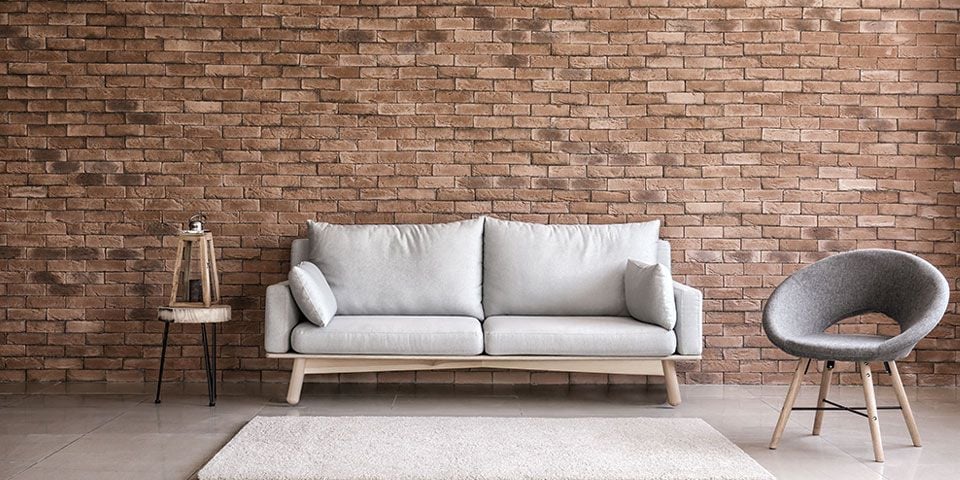How To Paint Interior Brick

Have you decided that the natural color of brick is not the right fit for your home’s aesthetic?
So, we’ve discussed previously whether painting the brick elements of your home is the best option for you. If you were able to answer those questions and confidently conclude that painting is the solution, here’s the ultimate guide to painting interior brick.
Prepping and painting interior brick is a less labor-intensive process than painting exterior brick. Plus, it requires milder cleaning solutions to remove the built-up dirt and soot around fireplaces.
But before you cover the surface, consider this: once you paint the brick, you can NEVER return to its original state. Brick is a very porous material, so when you paint it, it’ll soak that up like a sponge. When you attempt to later remove that layer of paint, the residual color will always remain in the nooks, crannies, and indentations in the brick.
Also, keep in mind that, while less physically demanding than painting exterior brick, painting an interior brick wall can still be a time-consuming process. While rolling paint onto the surface is effective, you will need to go back over it with a paintbrush to paint the mortar and to catch the paint that drips out of the pores in the brick’s surface. It requires serious attention to detail.
You should expect to buy at least twice the amount of paint, primer, and the cleaning solution you’d need for a non-brick wall of the same size. And we highly recommend using higher quality products to guarantee a long-lasting result.
Materials and Tools You’ll Need
- Natural stiff-bristled brush
- Soap
- Water
- Trisodium phosphate (optional)
- Paintbrush designed for textured surfaces
- Paint roller designed for textured surfaces
- Latex primer
- Masonry or latex paint
- Drop cloths
- Painter’s tape
How to Prep Brick for Painting
This is an important step in the process, so make sure you don’t skip over it: the brick must be thoroughly cleaned before it can be painted.
For interior brick, use a natural brush with stiff bristles to remove cobwebs, dust, and efflorescence (that crystalline white deposit that forms on the brick’s surface). We recommend using a natural brush, while other sources you read may suggest a brush with metal or wire bristles, which can damage the brick.
A mixture of warm water and soap or a vinegar-water solution works well to clean the masonry. Just make sure to rinse it and let it dry thoroughly – for 24-48 hours.
If there are other substances on the brick – mold, mildew, or burnt material found around a brick fireplace – a more powerful solution may need to be used. Trisodium phosphate (TSP) is effective in addressing all of these concerns, but it is also very potent. Make sure to work in a well-ventilated area and wear safety gloves and goggles.
During the prep stage, you should check for any cracks or inconsistencies in the structural integrity of your brick that may require repointing or even professional help.
How to Paint Brick
Start by applying a single coat of latex primer to the surface of the brick. Add more coats to areas affected by mildew or efflorescence and allow the primer to dry completely.
When it comes to actually painting the brick, we recommend using a roller to cover the majority of the wall and a brush to paint the mortar and cracks that your roller is bound to miss.
For more advanced painters, you may find that a paint sprayer is the easiest and quickest method. Acrylic latex paint, or a paint specifically formulated for masonry, is your best option.
Acrylic latex is the best for both exterior and interior brick because it is highly resistant to mildew and moisture. A semi-gloss or gloss paint is a good choice for both as well because it’s easy to clean. If you’re painting the inside of a fireplace, make sure you’re using heat-proof paint.
Apply a second coat if necessary and then stand back and admire your handiwork. It looks great!
Expert Tips
- Staining brick is an alternative to painting that you may want to consider. This method works best on brick that’s in good condition, and it allows the natural texture of brick to shine through. The stain absorbs into the brick rather than coating it as paint does.
- Never paint damaged, dirty, or wet brick. The surface should be clean, dry, and in good condition before painting, otherwise, the process can damage the brick more.
- When cleaning the brick prior to painting, never use acidic cleaners. They will affect the final paint job and cause the layer of paint to disintegrate over time.
- Make sure you repair any small cracks in the brick with acrylic caulk before you lay down any primer or paint. Larger cracks or other damage may require a professional.
For more expert tips and inspiration, visit one of our store locations!
Enjoy Your Backyard All Fall Long

Now is the perfect time to take advantage of autumn’s mild days to prepare your backyard for the cold months ahead. But who’s to say you can’t still enjoy your backyard, spending time with your family, and cooking outdoors all fall long.
"*" indicates required fields


